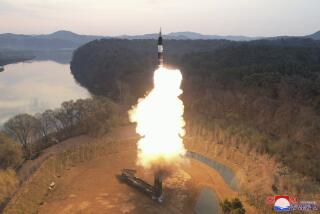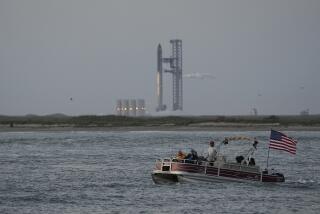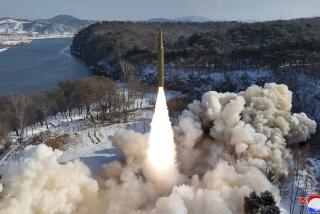Anti-Missile Weapon Undergoes Successful Flight Test : âStar Warsâ Rocket Destroys Target High in Sky; They Close In at 4 Times Speed of Sound
WASHINGTON â The Defense Department announced Friday that for the first time it has successfully flight tested a new anti-missile weapon against a battlefield missile capable of carrying a nuclear warhead.
The test, carried out Thursday at the White Sands Missile Range in New Mexico, used an experimental kinetic-energy, or force-of-impact, warhead to destroy a Lance tactical missile in flight. Closing at more than four times the speed of sound, the two weapons collided at an altitude of 12,000 feet over the desert and disintegrated in a bright ball of flame.
Pentagon officials said the test marked significant progress in one phase of the Reagan Administrationâs Strategic Defense Initiative. The âStar Warsâ program seeks to develop defenses against battlefield nuclear weapons as well as against longer-range strategic missiles. The officials said Thursdayâs test was applicable to both aspects of the program.
Radar-Guided Warhead
The device tested Thursday is known as the FLAGE missile, an acronym for Flexible Lightweight Agile Guided Experiment. Its radar-guided warhead is part of a family of kinetic-energy weapons designed to home in on and collide with their targets rather than destroying them from a distance by exploding.
It is progress along this line of development, rather than with more exotic lasers and other âdirected-energy weapons,â that has led Defense Secretary Caspar W. Weinberger and some other Administration officials to propose deploying a space-based strategic defense system by the early 1990s.
A number of scientists have questioned the feasibility of even a rudimentary system, which would rely on a vast array of sensors, communications and battle-management computers that are still to be developed. The Defense Department, however, maintains that steady progress is being made in proving that the basic technology for intercepting nuclear missiles with colliding warheads works.
Reporters Watch Film
In the test, the 12-foot FLAGE missile intercepted the Lance battlefield missile, launched from a distance of 32 miles, as it plunged from an altitude of 50,000 feet. A film shown to reporters at a Pentagon briefing shows the FLAGE streaking up from the desert floor against a bright blue sky, leaving a trail of smoke marked by white puffs as 140 of its 216 miniature rocket motors--each the size of a shotgun shell--fired to correct the warheadâs aim in the last stage of its seven-second flight.
Closing on the Lance at more than 3,000 m.p.h., the FLAGE is shown striking the incoming missile almost head-on, triggering a ball of flame from leftover fuel in the Lance.
âBoth were destroyed by kinetic energy alone. There was no explosion (of the warhead),â said Lt. Gen. John Wall, the commander of the U.S. Armyâs Strategic Defense Command, which conducted the test. Wall said the Administration considers the test to have been âfully consistentâ with the U.S.-Soviet Anti-Ballistic Missile Treaty of 1972.
Hit Two Previous Targets
In two previous tests last April and June, a FLAGE warhead collided with a 44-inch aluminum sphere suspended from a balloon and a target missile launched from an F-4 Phantom jet. Both targets, however, were artificially âenhancedâ to provide an easy mark for the FLAGE warheadâs on-board radar.
Wall noted that the Lance resembles in its size and flight characteristics the Soviet SS-21, a nuclear battlefield missile deployed in Eastern Europe.
More to Read
Sign up for Essential California
The most important California stories and recommendations in your inbox every morning.
You may occasionally receive promotional content from the Los Angeles Times.










